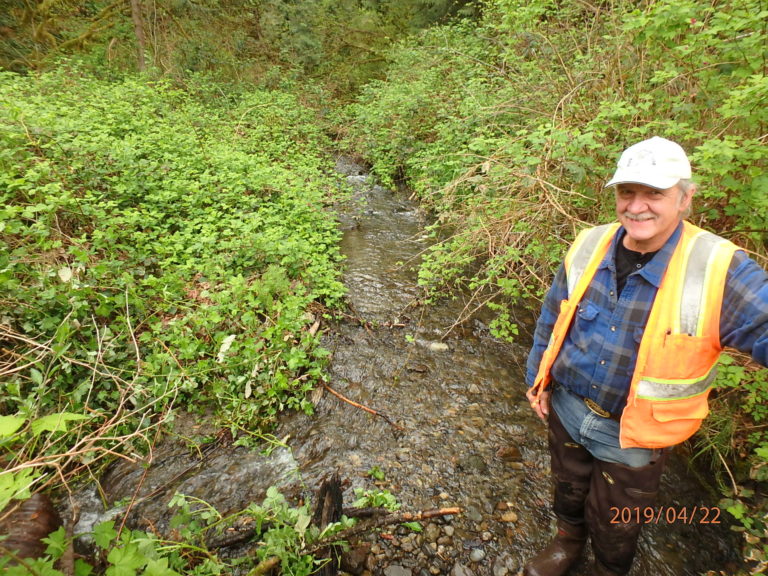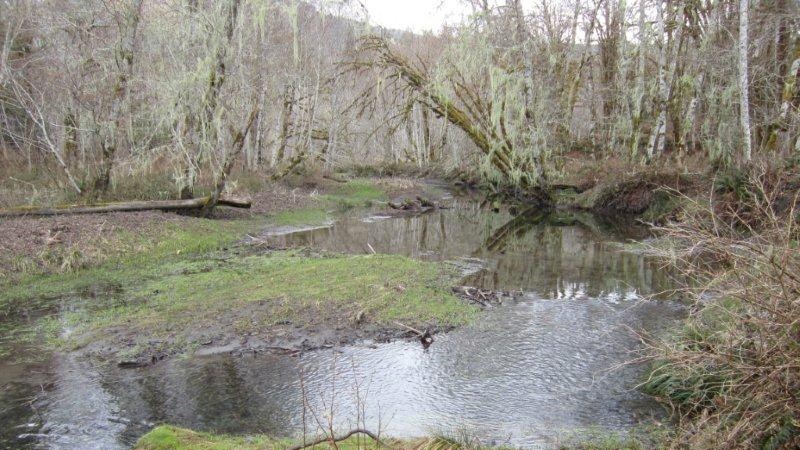

Fish habitat in both the Dosewallips and Duckabush Rivers in western Washington has been severely impacted by former land-use practices, specifically the clearing of wood from the rivers and the logging of riparian forests. This has led to decreased pool frequency, floodplain connectivity, and in-streasm sediment stability, as well as a lack of in-stream rearing habitat for juvenile fish. The Dosewallips River Habitat Assessment (2005) characterizes that river as moderately impaired, lacking key large woody debris (LWD). Smaller LWD is relatively abundant in the river, however this wood is highly mobile and generally does not form stable, persistent wood jams. Conditions in the Duckabush are similar.
Jefferson County worked with Jefferson Land Trust to clean up these properties, removed weeds, install a gate, and replant with conifers and other native seedlings. The Duckabush portion of the project was also expanded to include replanting and weed control on two acres of the adjacent Selfridge property which had recently been acquired by the Jefferson Land Trust. In addition, the Dosewallips portion of the project was expanded to include replanting and underplanting over a 30-acre portion of floodplain property located along the south bank of the river on parcels previously acquired by Jefferson County.
This project resulted in protection and restoration of a significant portion of the most active channel migration zone on the Duckabush and Dosewallips Rivers. The area seems increasingly well regarded by the local community and incidents of littering and/or vandalism have become rarer over time. Due to the abundance of fish and wildlife, the Berntsen/Selfridge area is a popular destination for natural history groups organized by Jefferson Land Trust. It’s likely that visitation and use will continue to increase as more people become aware of this beautiful site for day recreation and interpretation. The Dosewallips floodplain addition is dominated by red alder but has now been fully underplanted with conifers which, climate change willing, will eventually contribute large amounts of durable in-channel wood to the system. The project’s matching Fulton property on the Dosewallips is an appreciated shoreline open space parcel in the Lazy C subdivision. The trees where the Fulton home was formerly located are now reaching 20′ in height and more. The side channel which had been eroding the bank where restoration (and bank armoring further downstream on a different parcel) has occured, but this stretch of channel is now filled with dry gravel. The river is now located on the far side of the channel migration zone giving the new trees some time to grow This is improving odds of survival for the Fulton/Larson forest planted (in 2008 or so).
Location | Start Date |
|---|---|
Dosewallips and Duckabush Rivers, Hood Canal, western Washington State | 12/13/2007 |
Project Type | Completion Date |
|---|---|
Planning & Design | 12/13/2007 |
The primary goal of the project was to protect existing high quality habitat of the Duckabush and Dosewalllips river floodplains critical to chinook recovery. Objectives included fee simple acquisition of the Berntsen-Poetter property, weed control, removal of solid waste and a derelict vehicle, prevention of ATV access, decommissioning a driveway, decommissioning an on-site system (Selfridge) and replanting to native species.
Primary Habitats Impacted By Project: | Managing Agency/ Organization: |
|---|---|
Upper anadromous reaches of the Dosewallips and Duckabush Rivers | Wild Fish Conservancy |
Project Contact: | Budget or Project Cost: |
|---|---|
Micah Wait | $439,140.00 |
Funding Sources: | Partners: |
|---|---|
Puget Sound Acq. & Restoration | Washington State Recreation and Conservation Office (RCO) Hood Canal Coordinating Council Lead Entity |
Join our mailing list to recieve important updates on our work, the latest wild fish news, & opportunities to take action to support wild fish.
This site is protected by reCAPTCHA and the Google Privacy Policy and Terms of Service apply.
Wild Fish Conservancy is recognized as a 501(c)3 non-profit by the IRS